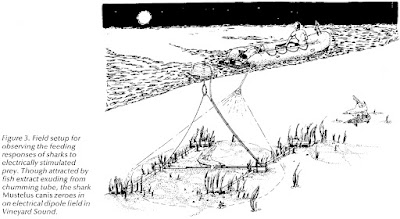Adrianus Kalmijn, a biophysicist known for his studies of electroreception in sharks, died December 7, 2021, at the age of 88.
In Chapter 9 of Intermediate Physics for Medicine and Biology, Russ Hobbie and I discuss Kalmijn’s work.
Kalmijn et al. discovered that the ocean flounder generates a current dipole of 3 × 10−7 A m. Sea water with resistivity of 0.23 Ω m gives an electric field of 2 × 10−5 V m−1 at a distance 10 cm in front of the flounder. They were able to show in a beautiful series of behavioral experiments that dogfish (a small shark) could detect the electric field 0.4 m from a current dipole of 4 × 10−7 A m, corresponding to an electric field of 5 × 10−7 V m−1. The fish would bite at the electrodes, ignoring a nearby odor source. A field of 10−4 V m−1 would elicit the startle response. A field ⅒ as large caused a physiologic response.
 |
| Kalmijn, A. J. (1977) The electric and magnetic sense of sharks, skates, and rays. Oceanus 20:45–52. |
My favorite paper by Kalmijn is
Kalmijn, A. J. (1977) The electric and magnetic sense of sharks, skates, and rays. Oceanus 20:45–52.Below is an excerpt.
During the summer of 1976, we learned from longline fishing off Cape Cod that the smooth dogfish Mustelus regularly frequents the shallow, inshore waters of Vineyard Sound on its nightly feeding excursions. This predatory shark is a warm-season visitor, arriving at Woods Hole in May and leaving for the South again in late October or shortly thereafter. It is an active bottom hunter, preying on small fish as well as crustaceans and other invertebrate animals. The females reach an average length of 115 centimeters; the males are slightly smaller. The smooth dogfish is truly live-bearing; the new-born measure 29 to 37 centimeters.
To observe the sharks’ feeding behavior, we worked from an inflatable rubber raft (Zodiac Mark II) free of any metal under the waterline. On station in 2.5 to 3.0-meter-deep water over a sand patch devoid of seaweed, we attracted the sharks by squeezing liquified herring through a long Tygon tube that ran from the raft to the bottom of the sea. The Tygon chumming tube was attached to a polypropylene line, suspended from a Styrofoam float and stretched over the ocean floor between two polyvinyl pipes anchored in low-profile cinder blocks (Figure 3). Starting after dark, we illuminated the area with a 100-watt, battery-operated underwater light. To break the water surface, we used a glass-bottom viewing box secured behind the stern of the raft.
 |
| Figure 3 from Kalmijn, A. J. (1977) Oceanus 20:45–52. With permission from the Woods Hole Oceanographic Institution. |
Two pairs of agar-filled, salt-bridge electrodes were tied to the polypropylene line and positioned on the sand, one on either side of the odor source and 30 centimeters from it. Mekka underwater plugs with stainless steel pins and integral cables connected the thin, 30 to 90-centimeter-long Silastic salt-bridge tubes to the electrical equipment set up in the rubber raft. The use of a constant-current source virtually eliminated the adverse effects of polarization at the stainless steel/seawater interfaces. From the raft, we could conveniently vary the strength of the field and select the pair of electrodes to be energized, the other pair functioning as the control. The applied direct-current dipole moments ranged from 1 to 8 microamperes × 5 centimeters (dipole current × distance between electrodes), roughly corresponding to the bioelectric fields of small prey at a seawater resistivity of 20.0 to 20.5 ohm·centimeters and a temperature of 19 to 22 degrees Celsius.
After entering the area, the smooth dogfish began frantically searching over the sand, apparently trying to locate the odor source. Both young and mature sharks were observed, sometimes alone, sometimes in groups of two to five. Neither the raft nor the underwater light appeared to bother them. Most interestingly, when nearing the odor source, the animals did not bite at the opening of the chumming tube but from distances up to 25 centimeters turned sharply to the current-electrodes, viciously attacking the electrically simulated prey. After snapping the line with their teeth right at the position of the electrodes, the sharks usually attempted to rip them apart—and one night they succeeded. When the current was switched to the other pair of electrodes, the animals let go, circled around for awhile, and attacked again, but at the electrodes on the other side of the odor source. At the lower current levels, the sharks kept responding, though from increasingly shorter distances.You can find an obituary of Kalmijn at the Scripps Institution of Oceanography website. It states
These observations convincingly demonstrate that odor-motivated sharks are capable of detecting and taking prey by the exclusive use of their electric sense, not only under well-controlled laboratory conditions, but also in their electrically more noisy, ocean habitat.
Family members remember Kalmijn as a renaissance man and a maverick. His work was his passion. He set a very high standard of integrity in his work and sought truth, accuracy, and scientific insight.
As a scientist, you can’t ask for more than that.



For an obituary of Kalmijn in The Scientist, see: https://www.the-scientist.com/news-opinion/biophysicist-adrianus-kalmijn-dies-at-88-69602
ReplyDelete